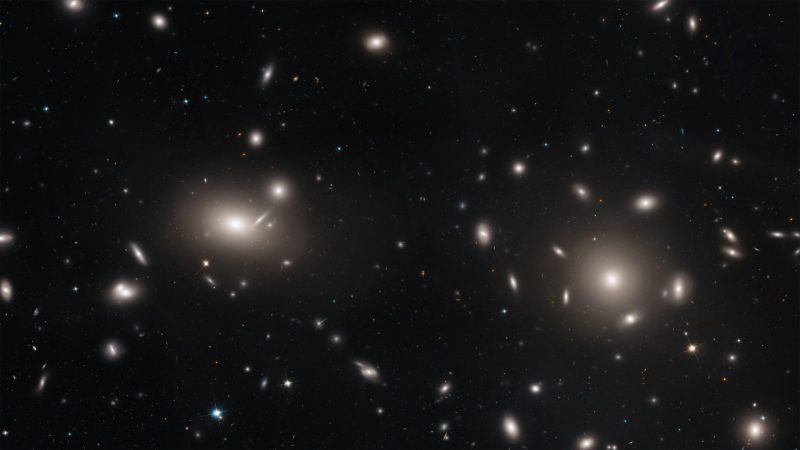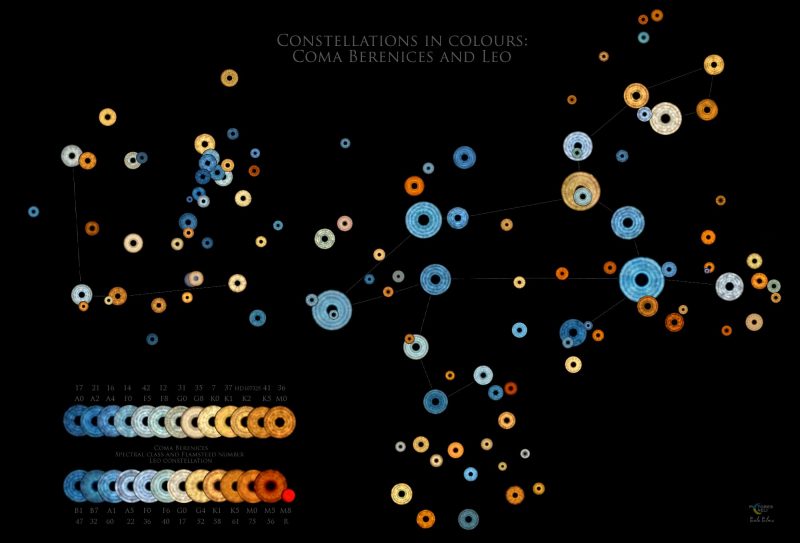
The Coma Berenices galaxy cluster
Thousands of galaxies lie in the Coma Berenices cluster. It’s one of the densest known galactic groupings visible through telescopes from Earth. It’s located in the direction of our constellation Coma Berenices. And it’s best viewed in the evening in April and May. The center of the Coma Berenices cluster is about 320 million light-years away. The cluster spans a distance of space of about 20 million light-years. That’s in contrast to our home galaxy, the Milky Way, about 100,000 light-years wide.
And the Coma Berenices cluster isn’t just one galaxy. It’s a huge collection of these star islands in space, filled with galaxies of all shapes and sizes, from giant ellipticals to spirals to dwarf galaxies.
An old – but beautiful – name for this region of sky is the Realm of the Galaxies. Writing an article by that name for Frosty Drew Observatory in the year 2000, the late Leslie Coleman, a previous director of Frosty Drew, explained:
Even in the eyepiece of the 16″, many of the galaxies in this area overlap each other! There simply isn’t room enough in this region of the sky to fit them.
It occupies a small area of sky
The central part of the Coma Berenices cluster covers a roughly circular area about 1 1/2 degrees across. That’s nine times the area of a full moon, which is about 1/2 a degree across. However, the full cluster may extend farther, and numerous other galaxy clusters are in the same area of the sky.
The constellation Coma Berenices lies between the constellations Leo the Lion and Boötes the Herdsman. This part of the sky is the site of the famous open star cluster known as the Coma Berenices star cluster, as well as the most distant galaxy cluster visible through telescopes. To see the star cluster and the galaxy cluster you need a dark sky.

How to find the Coma Berenices galaxy cluster
The galaxy cluster is near the northern border of the constellation Coma Berenices.

The cluster contains thousands of galaxies
The constellation Coma Berenices appears to the eye as a cluster of stars. But a telescope reveals a vast region of distant galaxies in this part of the sky. The chart below gives you an idea of the number of galaxies in that region of the sky.
No idea how twitter renders this image but "faint fuzzy" time! ASI533/8"SCT Alt/Az 50x5s subs looking thru to Coma Cluster of Galaxies. 300Mly away. Looking thru Galactic pole. Like shooting fish in a barrel! SkySafari labels two as IC 4040? Mag 15.4 captured! @BristolAstroSoc pic.twitter.com/pd3ssZn6lE
— Chris Lee FRAS FBIS (@cpl43uk) February 15, 2021
Science of the Coma Berenices galaxy cluster
So, the center of the Coma Berenices galaxy cluster is about 320 million light-years away. And it’s not getting any closer! In fact, the entire cluster is flying away from us at the rate of about more than 15 million mph (24 million kph)!
The Coma Berenices galaxy cluster is one of the most populated galaxy clusters known. And scientists estimate that it contains as many as 10,000 or more members. There are more individual galaxies in this cluster than there are stars visible to the unaided human eye on a clear, dark night.

A myriad of galaxies
Most galaxies in the central part of the cluster are elliptical. Elliptical galaxies are the result of galaxy mergers. The two brightest members are NGC 4889 and NGC 4874, both of which are giant ellipticals. They are at least two to three times larger than our own Milky Way galaxy. Farther out from the center are several spiral galaxies.
But most galaxies in the Coma Berenices galaxy cluster are dwarf galaxies. Maybe they resemble the Milky Way’s companions, the Large and Small Magellanic Clouds.

Coma Berenices galaxy cluster in history
Too faint for viewing by the human eye (or binoculars and even small telescopes), the ancients could not have seen the galaxy cluster. Hence, it has no associated mythology. However, the Coma Berenices galaxy cluster still has an interesting history.
Not only it is one of the largest and most densely populated clusters of galaxies known, it also led to our discovery of dark matter in our universe. Unseen and mysterious, this matter greatly increases the total mass and gravitational strength of the universe, affecting its evolution and fate.
Dark matter was unknown and unsuspected until Swiss-American astronomer Fritz Zwicky discovered it in the Coma Berenices galaxy cluster in the 1930s. Zwicky tallied up the visible galaxies in the cluster and estimated their masses. Then he observed the motions of galaxies near the edge of the cluster, which are determined by the total gravity (and hence mass) of the cluster. Zwicky found that the mass derived from the latter method greatly exceeded that from visual inspection.
Zwicky knew that if the law of gravity is correct – and there is no reason to doubt it – the only answer could be an additional source of mass, which he called dunkle Materie in German.
Today, scientists see the imprint of dark matter throughout the universe. It’s at least five times more prevalent than the more familiar visible matter, such as the stars and galaxies we can see.

Coordinates of the Coma Berenices galaxy cluster
The center of the Coma Berenices galaxy cluster is located at approximately RA: 12h 59m, dec: +27° 59′.
Bottom line: Myriads of galaxies, visible only to those with telescopes, shine among the stars of the constellation Coma Berenices. This is the distant Coma Berenices galaxy cluster.
The post The Coma Berenices galaxy cluster, best in April and May first appeared on EarthSky.
from EarthSky https://ift.tt/cEv0Uke

The Coma Berenices galaxy cluster
Thousands of galaxies lie in the Coma Berenices cluster. It’s one of the densest known galactic groupings visible through telescopes from Earth. It’s located in the direction of our constellation Coma Berenices. And it’s best viewed in the evening in April and May. The center of the Coma Berenices cluster is about 320 million light-years away. The cluster spans a distance of space of about 20 million light-years. That’s in contrast to our home galaxy, the Milky Way, about 100,000 light-years wide.
And the Coma Berenices cluster isn’t just one galaxy. It’s a huge collection of these star islands in space, filled with galaxies of all shapes and sizes, from giant ellipticals to spirals to dwarf galaxies.
An old – but beautiful – name for this region of sky is the Realm of the Galaxies. Writing an article by that name for Frosty Drew Observatory in the year 2000, the late Leslie Coleman, a previous director of Frosty Drew, explained:
Even in the eyepiece of the 16″, many of the galaxies in this area overlap each other! There simply isn’t room enough in this region of the sky to fit them.
It occupies a small area of sky
The central part of the Coma Berenices cluster covers a roughly circular area about 1 1/2 degrees across. That’s nine times the area of a full moon, which is about 1/2 a degree across. However, the full cluster may extend farther, and numerous other galaxy clusters are in the same area of the sky.
The constellation Coma Berenices lies between the constellations Leo the Lion and Boötes the Herdsman. This part of the sky is the site of the famous open star cluster known as the Coma Berenices star cluster, as well as the most distant galaxy cluster visible through telescopes. To see the star cluster and the galaxy cluster you need a dark sky.

How to find the Coma Berenices galaxy cluster
The galaxy cluster is near the northern border of the constellation Coma Berenices.

The cluster contains thousands of galaxies
The constellation Coma Berenices appears to the eye as a cluster of stars. But a telescope reveals a vast region of distant galaxies in this part of the sky. The chart below gives you an idea of the number of galaxies in that region of the sky.
No idea how twitter renders this image but "faint fuzzy" time! ASI533/8"SCT Alt/Az 50x5s subs looking thru to Coma Cluster of Galaxies. 300Mly away. Looking thru Galactic pole. Like shooting fish in a barrel! SkySafari labels two as IC 4040? Mag 15.4 captured! @BristolAstroSoc pic.twitter.com/pd3ssZn6lE
— Chris Lee FRAS FBIS (@cpl43uk) February 15, 2021
Science of the Coma Berenices galaxy cluster
So, the center of the Coma Berenices galaxy cluster is about 320 million light-years away. And it’s not getting any closer! In fact, the entire cluster is flying away from us at the rate of about more than 15 million mph (24 million kph)!
The Coma Berenices galaxy cluster is one of the most populated galaxy clusters known. And scientists estimate that it contains as many as 10,000 or more members. There are more individual galaxies in this cluster than there are stars visible to the unaided human eye on a clear, dark night.

A myriad of galaxies
Most galaxies in the central part of the cluster are elliptical. Elliptical galaxies are the result of galaxy mergers. The two brightest members are NGC 4889 and NGC 4874, both of which are giant ellipticals. They are at least two to three times larger than our own Milky Way galaxy. Farther out from the center are several spiral galaxies.
But most galaxies in the Coma Berenices galaxy cluster are dwarf galaxies. Maybe they resemble the Milky Way’s companions, the Large and Small Magellanic Clouds.

Coma Berenices galaxy cluster in history
Too faint for viewing by the human eye (or binoculars and even small telescopes), the ancients could not have seen the galaxy cluster. Hence, it has no associated mythology. However, the Coma Berenices galaxy cluster still has an interesting history.
Not only it is one of the largest and most densely populated clusters of galaxies known, it also led to our discovery of dark matter in our universe. Unseen and mysterious, this matter greatly increases the total mass and gravitational strength of the universe, affecting its evolution and fate.
Dark matter was unknown and unsuspected until Swiss-American astronomer Fritz Zwicky discovered it in the Coma Berenices galaxy cluster in the 1930s. Zwicky tallied up the visible galaxies in the cluster and estimated their masses. Then he observed the motions of galaxies near the edge of the cluster, which are determined by the total gravity (and hence mass) of the cluster. Zwicky found that the mass derived from the latter method greatly exceeded that from visual inspection.
Zwicky knew that if the law of gravity is correct – and there is no reason to doubt it – the only answer could be an additional source of mass, which he called dunkle Materie in German.
Today, scientists see the imprint of dark matter throughout the universe. It’s at least five times more prevalent than the more familiar visible matter, such as the stars and galaxies we can see.

Coordinates of the Coma Berenices galaxy cluster
The center of the Coma Berenices galaxy cluster is located at approximately RA: 12h 59m, dec: +27° 59′.
Bottom line: Myriads of galaxies, visible only to those with telescopes, shine among the stars of the constellation Coma Berenices. This is the distant Coma Berenices galaxy cluster.
The post The Coma Berenices galaxy cluster, best in April and May first appeared on EarthSky.
from EarthSky https://ift.tt/cEv0Uke

Aucun commentaire:
Enregistrer un commentaire